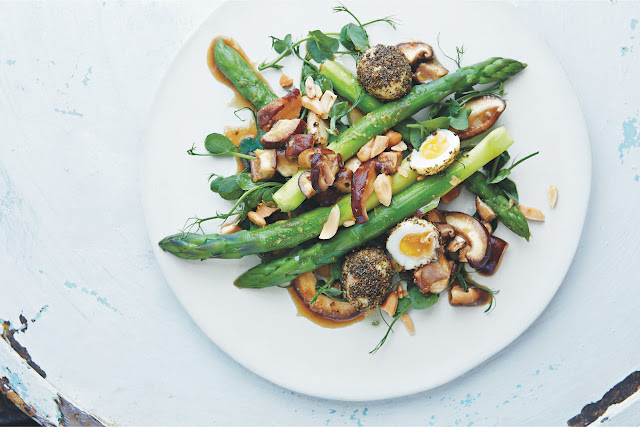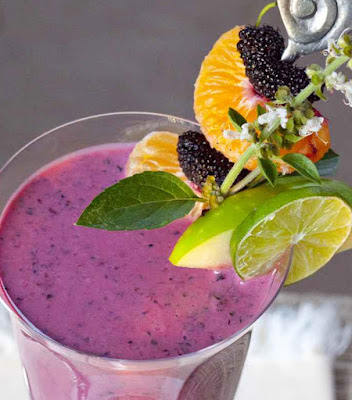Prepare For a Green Party With Chef Peter Gordon
In Celebration of Earth Day April 22nd
for 4 as a starter
Asparagus, almonds,
spiced quail eggs and shiitake
with miso dressing
spiced quail eggs and shiitake
with miso dressing
slightly chilled or at room temperature
A beautiful, elegant salad full of vibrant flavours and contrasting textures. Quail eggs are tricky to peel: use your fingernails and a small sharp knife. If you're unable to source them, then hen's eggs work as a good substitute.
Ingredients:
1 tsp coriander seeds
½ tsp nigella seeds
¼ tsp cumin seeds
¼ tsp fennel seeds
12 quail eggs
1 tbsp white vinegar
300g (10½oz.) fresh shiitake mushrooms, stalks removed and discarded
800g (1lb. 12oz.) asparagus
1 handful salad leaves (I used pea shoots)
1 tbsp lemon juice
100g (3½oz./3 cup) almonds, toasted and roughly chopped (I used delicious marcona almonds from Spain)
for the miso dressing
1 tbsp soy sauce
2 tbsp mirin
1 tbsp miso paste (I used shiromiso)
2 tsp finely chopped or grated ginger
Method:
Lightly toast the coriander, nigella, cumin and fennel seeds in a dry frying pan (skillet) over a medium heat until they become aromatic. Leave to cool. Add ½ teaspoon of flaky salt and grind the spices in a spice grinder or using a mortar and pestle.
Place the quail eggs in a pan large enough to hold them in a single layer. Pour in enough water to cover by 3cm (1¼in.), add the vinegar, bring to the boil and cook for 3 minutes.
Drain into a sieve or colander, then place in a bowl of iced water and leave for 5 minutes.
Peel the eggs and roll them in the ground spices.
Drain into a sieve or colander, then place in a bowl of iced water and leave for 5 minutes.
Peel the eggs and roll them in the ground spices.
To make the dressing, mix the soy, mirin, miso paste and ginger until the miso has ‘dissolved’, then stir in 2 tablespoons of warm water.
Bring 200ml (¾ cup) of water to the boil in a medium pan. Slice half the shiitake mushrooms and dice the other half. Add to the boiling water, give a good stir for 20 seconds, then drain into a colander. Leave for 30 seconds, then tip into a bowl and mix in the miso dressing.
Cover with cling film (plastic wrap) and leave to marinate, stirring again after 10 minutes.
Cover with cling film (plastic wrap) and leave to marinate, stirring again after 10 minutes.
Snap the ends from the asparagus and peel the lower 3cm (1¼in.). Blanch in salted boiling water, or steam, for 1½ minutes, then refresh in iced water. Drain..
To serve, toss the asparagus and salad leaves with the lemon juice and lay them on your plates. Spoon on the mushrooms and marinating juices, then tuck in the quail eggs and scatter with the almonds.
Savour by Peter Gordon. Published by Jacqui Small, an imprint of The Quarto Group (£25). Out now. Photography by Lisa Linder.
Peter Talks
As a chef and restaurateur, I am constantly sourcing, buying, cooking, serving and then often eating hundreds of ingredients every week. The style of food I’m known for is Fusion Cuisine and this means I like to source ingredients that can come from any part of the world.
Whilst I am all about buying local ingredients in season and supporting local jobs, it is worth noting that many imported ingredients are also sustainable, sometimes with surprisingly low carbon footprints. Not everything can be grown in our British climate - hence gorgeous organic pineapples from Ghana are as appealing to me as Scottish raspberries and a Dover Sole - freshly caught by a day boat off the Southern Coast. At the moment British asparagus is in season and that’s what we should all be buying (cf asparagus from further away) as it is spankingly fresh and a truly remarkable ingredient that is with us for such a short time. It provides local employment and the commerce and trade it generates helps our local economy.
I’ve included a recipe that really makes the most of its texture and flavour - but teamed it with some imported ingredients - although British grown shiitake mushrooms are becoming easier to source and they taste terrific.
I’ve also included a recipe for a baobab smoothie. Baobab cannot be grown in Britain (just like tea, coffee, cacao, vanilla, most spices and many other things we have to import) and many people in Africa rely on the harvesting and processing of this fabulous fruit for their livelihoods. You can easily buy it over the internet or in some forward think health-food stores as a powder which you can sprinkle on your cereal or mix into drinks. We also use baobab oil in some of our products at Dr Jackson's such as our 01 Day Cream, 02 Night Cream, 03 Face Oil, 05 Face & Eye Essence, 06 Body Perfecting Gel and our Baobab & Rose Oil.
Whilst I am all about buying local ingredients in season and supporting local jobs, it is worth noting that many imported ingredients are also sustainable, sometimes with surprisingly low carbon footprints. Not everything can be grown in our British climate - hence gorgeous organic pineapples from Ghana are as appealing to me as Scottish raspberries and a Dover Sole - freshly caught by a day boat off the Southern Coast. At the moment British asparagus is in season and that’s what we should all be buying (cf asparagus from further away) as it is spankingly fresh and a truly remarkable ingredient that is with us for such a short time. It provides local employment and the commerce and trade it generates helps our local economy.
I’ve included a recipe that really makes the most of its texture and flavour - but teamed it with some imported ingredients - although British grown shiitake mushrooms are becoming easier to source and they taste terrific.
I’ve also included a recipe for a baobab smoothie. Baobab cannot be grown in Britain (just like tea, coffee, cacao, vanilla, most spices and many other things we have to import) and many people in Africa rely on the harvesting and processing of this fabulous fruit for their livelihoods. You can easily buy it over the internet or in some forward think health-food stores as a powder which you can sprinkle on your cereal or mix into drinks. We also use baobab oil in some of our products at Dr Jackson's such as our 01 Day Cream, 02 Night Cream, 03 Face Oil, 05 Face & Eye Essence, 06 Body Perfecting Gel and our Baobab & Rose Oil.
Baobab Smoothie
with Blueberry, Mint, Basil & Spinach
Ingredients:
300ml plain yoghurt
300ml milk/fruit juice
3 tbsp baobab powder
4 tbsp honey
120g blueberries
handful mint & basil leaves
handful baby spinach leaves (stalks removed)
handful ice cubes (optional)
300ml milk/fruit juice
3 tbsp baobab powder
4 tbsp honey
120g blueberries
handful mint & basil leaves
handful baby spinach leaves (stalks removed)
handful ice cubes (optional)
Method:
Place everything in the blender and whizz for a minute. Consume immediately. Serves 2.
Place everything in the blender and whizz for a minute. Consume immediately. Serves 2.

Image: www.countryliving.com
At home I grow many herbs in my London Fields garden and in pots on the kitchen windowsill. There really is no excuse to buy plastic-wrapped herbs from the shops, as a tub of herbs will keep growing and are low maintenance (don’t over water as they’ll drown and don’t underwater or they’ll dry out) Plus, they give your kitchen a lovely aroma.
I've also planted many medium sized trees and shrubs that fill the space with greenery, provide nectar and seeds for bees and birds. Right now, I’m picking tulips and daffodils to fill my vases instead of having to buy flowers from the shops. My tea leaves always end up on the garden (they make good mulch), and when I have to use my clothes dryer (which drains into a condenser tub rather than out into the drain) I use this water on the garden. Both the tea water and dryer water help a little to reduce my water consumption.
At home I never buy bottled water. Instead I use a water filter for all of my drinking water; the thought of buying, carrying, and recycling endless plastic water bottles fills me with dread - it seems so pointless. I have a Sodastream which I carbonate the water with. Again, this saves both plastic and energy. If we all keep doing the little things that count this planet will live on for many years to come. If we don’t, I hate to think what might happen.
I've also planted many medium sized trees and shrubs that fill the space with greenery, provide nectar and seeds for bees and birds. Right now, I’m picking tulips and daffodils to fill my vases instead of having to buy flowers from the shops. My tea leaves always end up on the garden (they make good mulch), and when I have to use my clothes dryer (which drains into a condenser tub rather than out into the drain) I use this water on the garden. Both the tea water and dryer water help a little to reduce my water consumption.
At home I never buy bottled water. Instead I use a water filter for all of my drinking water; the thought of buying, carrying, and recycling endless plastic water bottles fills me with dread - it seems so pointless. I have a Sodastream which I carbonate the water with. Again, this saves both plastic and energy. If we all keep doing the little things that count this planet will live on for many years to come. If we don’t, I hate to think what might happen.
Peter Gordon




